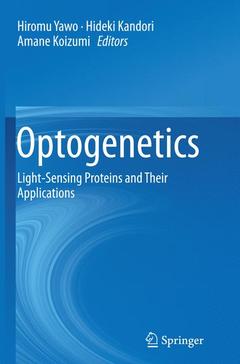Optogenetics, Softcover reprint of the original 1st ed. 2015 Light-Sensing Proteins and Their Applications
Coordonnateurs : Yawo Hiromu, Kandori Hideki, Koizumi Amane

The subject of optogenetics is comprehensively covered in this book, including physical, chemical, and biological topics of light-sensing proteins and their application in biological systems, particularly in neuroscience and medicine and the related opto-electronics. Optogenetics is a new technology that combines genetics and optics. It enables one to manipulate or measure the function of identified cells or neurons in a tissue by light with an accuracy in the range of milliseconds, even in a freely moving animal. Optogenetics has already become a powerful tool for revealing the neural mechanisms underlying behavior and analyzing various physiological phenomena. It is also expected to become useful for treating neural dysfunctions such as Parkinson disease and for the development of a brain?machine interface. This book should be read by any scientist or student performing research in any way related to optogenetics. As a milestone publication on optogenetics, this book will serve asa compass for any researcher, from beginners to experts, to explore this uncharted world.
Part I Light-Sensing Proteins.- 1 History and Perspectives of Light-Sensing Proteins (Hideki Kandori).- 2 Biology of Light-Sensing Proteins in Plants and Microorganisms (Mineo Iseki and Tetsuo Takahashi).- 3 Structure-Functional Analysis of Channelrhodopsins (Hideaki E. Kato, Ryuichiro Ishitani, and Osamu Nureki).- 4 Photochemistry of Halorhodopsin (Takashi Kikukawa, Naoki Kamo, and Makoto Demura).- 5 Molecular Mechanisms for Ion Transportation of Microbial Rhodopsins Studied by Light-Induced Difference FTIR Spectroscopy (Yuji Furutani).- 6 Optogenetic Potentials of Diverse Animal Opsins (Akihisa Terakita, Takashi Nagata, Tomohiro Sugihara, and Mitsumasa Koyanagi).- 7 Color Tuning in Retinylidene Proteins (Kota Katayama, Sivakumar Sekharan, and Yuki Sudo).- Part II Optogenetics in Biological Systems.- 8 General Description: Future Prospects of Optogenetics (Hiromu Yawo, Ryo Egawa, Shoko Hososhima, and Lei Wen).- 9 Optogenetic Manipulation and Probing (Masamichi Ohkuraand Junichi Nakai).- 10 Probing Neuronal Activity Using Genetically Encoded Red Fluorescent Calcium Indicators (Takuya Sasaki).- 11 Optogenetic Sensors for Monitoring Intracellular Chloride (Ken Berglund, Lei Wen, and George J. Augustine).- 12 Optogenetic Imaging of Protein Activity in the Synapse by Using 2-photon Fluorescence Lifetime Imaging Microscopy (Hideji Murakoshi and Akihiro C E Shibata).- 13 Optogenetics in Drosophila (Hiroshi Kohsaka and Akinao Nose).- 14 Optogenetics in Caenorhabditis elegans (Yuki Tsukada and Ikue Mori).- 15 Optogenetics Research Using the Mouse as a Model System (Kenji F. Tanaka).- Part III Optogenetics in Neuroscience.- 16 Neuroscientific Frontline of Optogenetics (Akihiro Yamanaka).- 17 Elucidation of Neuronal Circuitry Involved in the Regulation of Sleep/Wakefulness Using Optogenetics (Tomomi Tsunematsu and Akihiro Yamanaka).- 18 Optogenetic Analysis of Striatal Connections to Determine Functional Connectomes (Nao Chuhma).- 19 Potentialof Optogenetics for the Behavior Manipulation in Non-human Primates (Masaharu Kinoshita and Tadashi Isa).- 20 Activity Regulation in the Study of Neural Plasticity (Shoji Komai).- 21 Strategies to Probe Mechanoreception: From Mechanical to Optogenetic Approaches (Zhi-Gang Ji, Toru Ishizuka, and Hiromu Yawo).- 22 Casting Light on the Role of Glial Cells in Brain Function (Ko Matsui).- Part IV Medical Optogenetics.- 23 Towards Understanding the Neural Mechanism of Behavioral Phenotypes Seen in Psychiatric Disorders (Nobuhiro Nakai, Ofer Yizhar, and Toru Takumi).- 24 Establishment of Gene Therapy Using Channelrhodopsin-2 to Treat Blindness (Eriko Sugano and Hiroshi Tomita).- 25 Optogenetic Approaches to Restoring Intrinsic Visual Processing Features in Retinal Ganglion Cells (Zhuo-Hua Pan, Anding Bi, and Qi Lu).- 26 On Optogenetic Tissue Engineering on Visual Cells: A Review on Its Development, Practices, and Application (Misato Ichise and Seigo Yamada).- Part V Optogenetics andOpto-electronics.- 27 CMOS-based Neural Interface Device for Optogenetics (Takashi Tokuda, Toshihiko Noda, Kiyotaka Sasagawa, and Jun Ohta).- 28 Use of Channelrhodopsin in the Development of Neuron-Network High-Throughput Screening Devices (Tsuneo Urisu).- BM Index.
Date de parution : 10-2016
Ouvrage de 409 p.
15.5x23.5 cm
Thèmes d’Optogenetics :
Mots-clés :
Channelrhodopsin; Halorhodopsin; Neural circuits; Optical sensors; Psychiatry; Visual prosthesis



